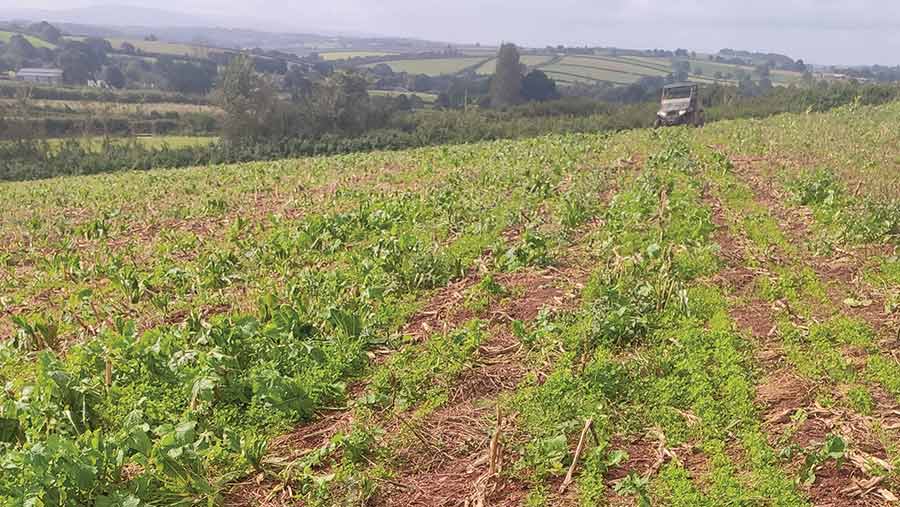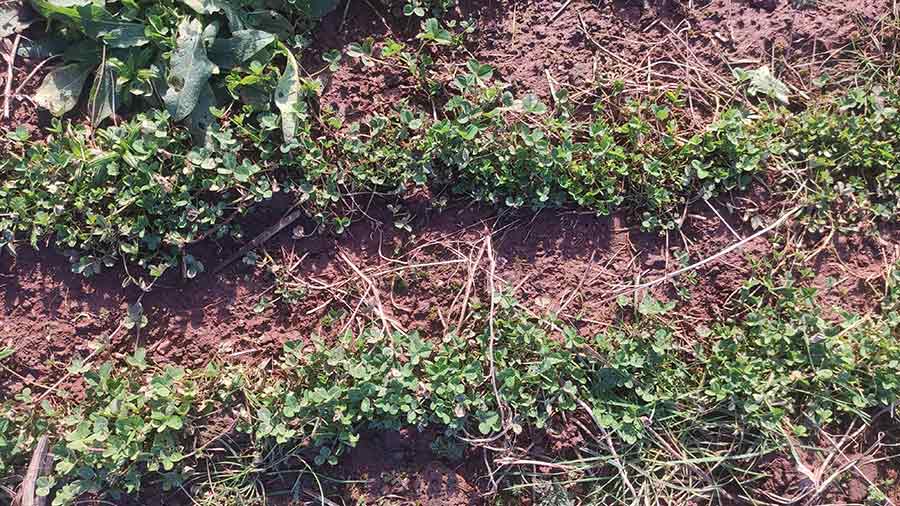Can living mulch cut maize cost and protect soil health?
 Clover mulch © Andy Gray
Clover mulch © Andy Gray Maize is an important component in livestock diets, but growing the crop is often associated with harmful environmental effects caused by soil erosion and run-off.
The tendency for maize ground to be left bare for long periods of time is also problematic.
Andy Gray, of Elston Farm, near Copplestone, Devon, is trialling an innovative potential solution to these issues.
He is growing maize on top of a perennial, white clover-based crop – otherwise known as a living mulch — as part of a study by farmer-led research group Innovative Farmers.
Elston Farm operates as a mixed system across 61ha (150 acres), with a small herd of beef cattle, red deer and an arable enterprise.
Maize is grown as a cash crop, supplying livestock feed for local dairy farms. While this is a good source of revenue, Andy does not like the effect the crop has on the land.
Environmental challenge
“Our soils were tired – they had no structure, poor porosity and they ran in heavy rain. We later tested carbon levels and they were low, despite years of min-till,” he says.
To help correct this, he has secured a five-year Mid Tier Countryside Stewardship agreement, which will involve putting most of the farm into herbal leys, after which the farm will return to arable cropping.
In the meantime, he is exploring ways to grow maize that better protect his soils. “I’ve got a south-facing farm, with deep soils that grow maize really well. We’ve also got a lot of people around us who want maize.
“It’s an easy crop to sell to our neighbours and we aspire to grow it, but we want to find other ways to grow it that don’t involve bare soils for so much of the year.”
Growing a living mulch
Andy decided to set up a trial with Innovative Farmers to find out whether, and how, growing maize on top of a living mulch could improve soil and plant health.
“The reason I want a living mulch is to be able to keep feeding our soils year round – not just when maize is producing sugars and other root exudates in its main growth period.
“Also, as the rows are wide apart, there is soil not receiving those exudates, especially during establishment,” he says.
He adds that healthier, better-fed soils are also likely to result in better maize crops, so the benefits are multifaceted.
“Maize is a great crop, but just grown badly in the wrong places, generally. We see having a mulch as a way of growing it well.”
Clover could provide nitrogen to the maize crop and enable him to reduce the need for synthetic fertilisers – something that aligns with the farm’s environmental ambitions.
A living mulch must have certain qualities, according to Innovative Farmers (see “Key components of a living mulch”).
However, the main challenge is that maize does not cope well with competition – as seen in previous trials where growing a living mulch with maize has been attempted.
This means the way the mulch is managed will be integral to the success of the trial, says Andy.
“We’re looking to grow something that is non-competitive and can be suppressed around the establishment period.
“That’s what this trial is about – seeing how far we can go to make the mulch non-competitive, without being utterly useless — as well as how we can suppress it if it looks like it’s getting ahead of the maize.”
Trial design
Elston Farm is in the first year of the three-year trial. The trial site comprises a 4ha (10-acre) plot divided into three areas: one with no mulch, and two with a living mulch of dwarf white clover.
The reason for the two clover plots is to test two suppression methods – glyphosate or grazing sheep, used before the next crop of maize is drilled – to see which is most effective, says Andy.
Ground for the first crop was shallow-cultivated before drilling on 23 May last year. Five weeks later, when the maize had reached the three-leaf stage, the clover was drilled using an inter-row drill.
The next crop of maize will be strip-tilled into the living mulch this May, weather conditions permitting.
The variety of clover was simply the one supplied by his local seed merchant, says Andy.
However, he adds it might be worth looking at different varieties in a future trial, if he can prove the concept of a living mulch to be a success first.
Innovative Farmers is carrying out data collection and analysis, and captured baseline soil carbon levels before the project started.

Clover mulch © Andy Gray
Next steps
Following the maize harvest last year, Andy says the mulch was left looking quite patchy, with distinct areas needing reseeding.
“Once it gets going, it’ll probably become more of a complete cover, but I was quite intrigued to see that it wasn’t overly competitive compared with the maize,” he adds.
After this year’s harvest, the trial will be repeated for a further two years, followed by soil sampling after the fourth harvest, in September/October 2026. At this point, soil organic matter and soil carbon levels will be measured again.
Though living mulches have been trialled, and failed, before in the UK, Andy is confident there are ways of making it work.
“The benefit to us, if we can make it work, is that it opens up a crop that almost feels unacceptable to grow at the minute [because of the environmental effects],” he says.
“The nice thing about maize is that it pops all that carbon into the soil in the summer, and then the clover will continue to feed and protect the soil through the rest of the year.
“From the point of view of improving the soil, this trial could be a perfectly good – possibly brilliant — way of improving soils while growing a high-ME [metabolisable energy] crop.
“There’s a lot of pressure on maize growers from policymakers, so this could provide a solution before that pressure is more firmly applied.”
Key components of a living mulch
To be most beneficial to soils and crops, a living mulch should do the following:
- Provide year-round ground cover in the maize fields, protecting the soil from erosion and nearby watercourses from nutrient-rich run-off
- Provide nitrogen to the crop (through nitrogen fixing), which in turn reduces the need for synthetic fertilisers
- Reduce the annual weed burden within the maize crop
- Provide grazing immediately after the maize harvest without having to wait for the cover crop to establish
- Increase soil organic matter and soil carbon storage.
Source: Innovative Farmers
